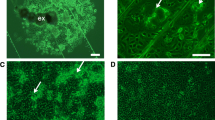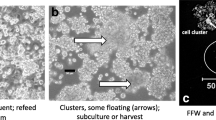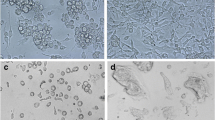Abstract
A new cell line, UM-AVE1, was established from embryos of the mosquito Aedes vexans. Banding patterns for the isozymes lactate dehydrogenase (LDH), malate dehydrogenase (MDH), isocitrate dehydrogenase (IDH), xanthine dehydrogenase (XDH), and esterases were compared with those of larval Aedes vexans tissues as well as those of four other mosquito cell lines and one moth cell line. Karyotype analyses confirmed that the dipteran cell lines were not contaminated with lepidopteran cells, because in all mosquito lines the modal number of chromosomes was 6 (=2n) or 7. Isozyme electrophoresis established a specific profile for each cell line. Two isozymes present in UM-AVE1 (LDH, IDH) were not detected in larvae; this could be a reflection of the different stages used for cell line isolation and enzyme analysis, or lability of sample preparations. It is significant that extracts from UM-AVE1 cells and Aedes vexans larvae had an identical double band for XDH, while all other cell lines examined exhibited only a single band.
Similar content being viewed by others
References
BrownSE and KnudsonDL (1980) Characterization of invertebrate cell lines III. Isozyme analyses employing cellulose-acetate electrophoresis. In Vitro 16: 829–832.
BrownSE and KnudsonDL (1982) Characterization of invertebrate cell lines IV. Isozyme analyses of dipteran and acarine cell lines. In Vitro 18: 347–350.
BurkeDS and LeakeCJ (1988) Japanese encephalitis. In: TPMonath (ed.) The Arboviruses: Epidemiology and Ecology Vol. III (pp. 64–92). CRC Press, Boca Raton, Fla.
CorsaroBG and FraserMJ (1987) Characterization of clonal populations of the Heliothis zea cell line IPLB-HZ1075. In Vitro Cell. and Dev. Biol. 23: 855–862.
DebecA (1974) Isozymic patterns and functional states of in vitro cultured lines of Drosophila melanogaster. Wilhelm Roux's Arch. 174: 1–19.
FritzMA and FallonAM (1987) Properties of a ribonuclease from Aedes aegypti larvae. Comp. Biochem. Physiol. 88B: 595–601.
GreeneAE and CharneyJ (1971) Characterization and identification of insect cell cultures. Curr. Top. Microbiol. Immunol. 55: 51–61.
GreeneAE, CharneyJ, NicholsWJ and CoriellLL (1972) Species identity of insect cell lines. In Vitro 7: 43–48.
GrimstadPR (1987) California group virus disease. In: TPMonath (ed.) The Arboviruses: Epidemiology and Ecology Vol. II (pp. 99–136). CRC Press, Boca Raton, Fla.
HerreraRJ and MukherjeeAB (1982) Electrophoretic characterization and comparison of dehydrogenases from eight permanent cell lines. Comp. Biochem. Physiol. 72B: 359–366.
KonoY (1988) Getah virus disease. In: TPMonath (ed.) The Arboviruses: Epidemiology and Ecology Vol. III (pp. 22–36). CRC Press, Boca Raton, Fla.
KurttiTJ and MunderlohUG (1989) Advances in the definition of culture media for mosquito cells. In: JMitsuhashi (ed.) Invertebrate Cell System Applications (pp. 21–29). CRC Press, Inc., Boca Raton, Florida.
McIntoshAH and IgnoffoCM (1983) Characterization of five cell lines established from species of Heliothis. Appl. Ent. Zool. 18: 262–269.
McLimansWF (1972) The gaseous environment of the mammalian cell in culture. In: GHRothblat and VJCristofalo (eds.) Growth, Nutrition and Metabolism of Cells in Culture Vol. I (pp. 137–170). Academic Press, New York, NY.
MorrisCD (1988) Eastern equine encephalomyelitis. In: TPMonath (ed.) The Arboviruses: Epidemiology and Ecology Vol. III (pp. 1–24). CRC Press, Boca Raton, Fla.
MunderlohUG and KurttiTJ (1989) Formulation of medium for tick cell culture. Exp. Appl. Acarol. 7: 219–229.
MunderlohUG, KurttiTJ and MaramoroschK (1982) Anopheles stephensi and Toxorhynchites amboinensis: aseptic rearing of mosquito larvae on cultured cells. J. Parasitol. 68: 1085–1091.
NicholsW, BradtC and BowneW (1971) Cytogenetic studies on cells in culture from the class Insecta. Curr. Top. Microbiol. Immunol. 55: 61–69.
PelegJ (1968) Growth of arboviruses in monolayers from subcultured mosquito embryo cells. Virology 35: 617–619.
PudneyM, LeakeCJ and BuckleySM (1982) Replication of arbovirus in arthropod in vitro systems: an overview. In: KMaramorosch and JMitsuhashi (eds.) Invertebrate Cell Culture Applications (pp 159–194). Academic Press, New York.
ReisenWK and MonathTP (1989) Western equine encephalomyelitis. In: TPMonath (ed.) The Arboviruses: Epidemiology and Ecology Vol. V (pp. 90–137). CRC Press, Boca Raton, Fla.
ShawCR and PrasadR (1970) Starch gel electrophoresis of enzymes — A compilation of recipes. Biochem. Genet. 4: 297–320.
SinghKRP (1967) Cell cultures derived from larvae of Aedes albopictus and A. aegypti. Curr. Sci. 36: 506–509.
St. GeorgeTD and StandfastHA (1989) Simbu group viruses with teratogenic potential. In: TPMonath (ed.) The Arboviruses: Epidemiology and Ecology Vol. IV (pp. 146–166). CRC Press, Boca Raton, Fla.
TabachaickWJ and KnudsonDL (1980) Characterization of invertebrate cell lines II. Isozyme analyses employing starch gel electrophoresis. In Vitro 16: 392–398.
TsaiTF and MitchellCJ (1989) St. Louis encephalitis. In: TPMonath (ed.) The Arboviruses: Epidemiology and Ecology Vol. IV CRC Press, Boca Raton, Fla.
Author information
Authors and Affiliations
Rights and permissions
About this article
Cite this article
Mazzacano, C.A., Munderloh, U.G. & Kurtti, T.J. Characterization of a new continuous cell line from the flood water mosquito, Aedes vexans . Cytotechnology 5, 147–154 (1991). https://doi.org/10.1007/BF00365431
Received:
Accepted:
Issue Date:
DOI: https://doi.org/10.1007/BF00365431




